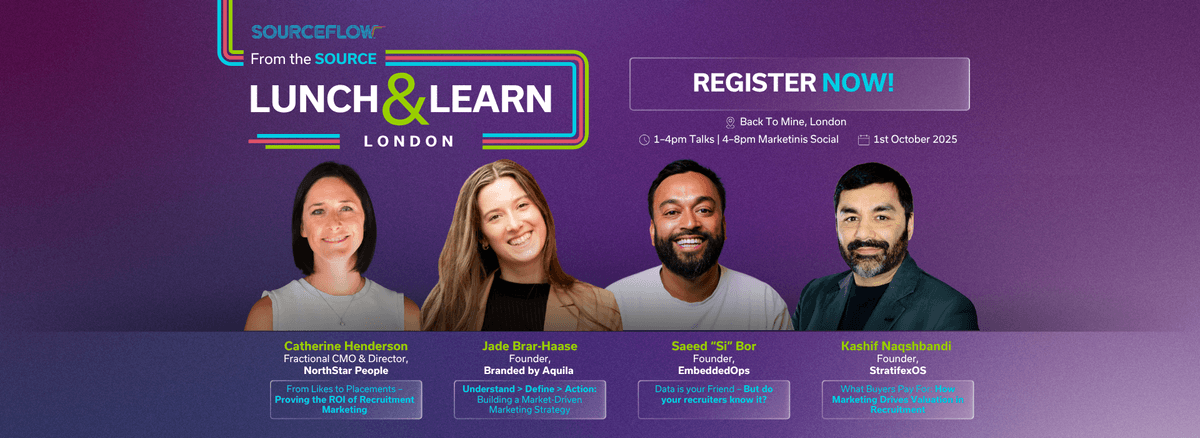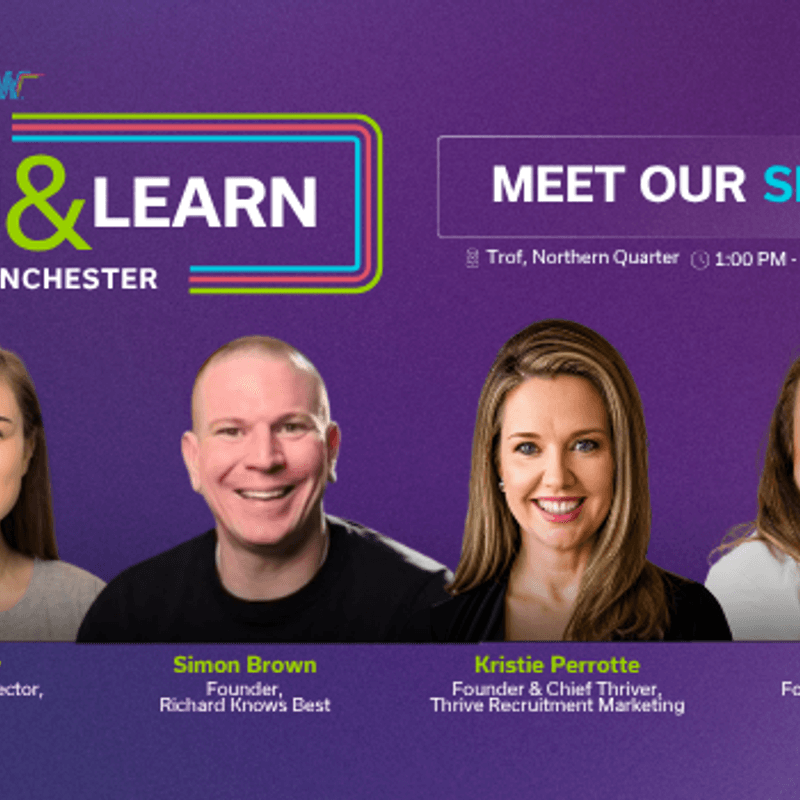
Events
Proving ROI in Recruitment Marketing: Lessons from SourceFlow’s London Lunch & Learn

Share
Four practical ways to make marketing measurable and growth-focused
On October 1, 2025, SourceFlow hosted its London Lunch & Learn, bringing together recruitment marketers, operations leaders, and agency founders to discuss one important question:
How can marketing in recruitment demonstrate commercial impact?
Four focused sessions explored that challenge from every angle: measurement, data, strategy, and valuation.
Here’s what the day revealed about recruitment marketing in 2025.
1. From Likes to Placements – Proving the ROI of Recruitment Marketing
Catherine Henderson, Director, Boudicca Consulting
Catherine opened the afternoon by encouraging marketers to be prepared with data that clearly connects their work to revenue.
Too often, she said, marketing teams measure the wrong things. LinkedIn followers, clicks, and impressions might be helpful indicators, but they don’t hold up in a board meeting.
“If your marketing can’t be traced to meetings, jobs or placements, it won’t win the budget conversation.”
She encouraged marketers to turn KPIs into commercial metrics: mapping campaigns to client meetings, tracking cost-per-placement, and building consistent feedback loops with recruiters and finance.
Key Takeaway: Marketers should measure success based on revenue and placements, not impressions or follower counts.
2. Data is Your Friend, But Do Your Recruiters Know It?
Saeed ‘Si’ Bor, Founder, EmbeddedOps
Next, Si reframed how data underpins performance. Recruitment, he said, depends on ratios and data is the connection between effort and outcomes.
He broke agency data into two main types:
Performance data (what’s being done) and CRM data (what’s being learned). Used together, they reveal not just how consultants perform, but why.
He urged agencies to modernize their coding models, capturing the qualitative detail learned in calls, not just LinkedIn-style filters. Done well, that data powers smarter targeting, stronger conversion ratios, and more meaningful marketing campaigns.
Marketers should work closely with operations, understand recruiter metrics, and use the CRM as a performance engine, not a storage system.
Key Takeaway: Recruiters and marketers need to collaborate, using CRM and performance data to improve efficiency and results.
3. Understand > Define > Action: Building a Market-Driven Marketing Strategy
Jade Brar-Haase, Founder, Branded by Aquila
Jade shifted the discussion from data to direction, explaining how structured planning supports alignment and sustainable growth.
Her three-step approach combined competitor analysis, customer insight, and measurable activity to form a marketing plan everyone can commit to.
“Quick wins are fine,” she said, “but they won’t get you through a downturn.”
She also shared a SAFE scoring framework (Suitability, Acceptable, Feasible) to help leaders prioritize initiatives and keep teams focused on what moves the needle.
Key Takeaway: Structured marketing plans supported by competitor analysis and clear value propositions help create stability and alignment.
4. What Buyers Pay For: How Marketing Drives Valuation in Recruitment
Kashif Naqshbandi, Founder, Stratifex OS
Kashif closed the event with a private equity perspective on how marketing influences business valuation.
Drawing on experience from two successful PE exits, he explained that buyers look beyond profit to the full narrative of a business: growth may attract attention, but a well-documented story builds trust and value.
He outlined practical steps for marketers to strengthen enterprise value: keep any single client below 10% of total revenue, build multi-threaded relationships across senior stakeholders, and develop measurable advocacy programs using NPS or case studies.
Marketing, he emphasized, is not just a cost center; it’s a key driver of long-term enterprise value.
Key Takeaway: Strong brands, client advocacy, and consistent communication all contribute to higher business valuations.
What’s Next?
Recruitment marketing continues to evolve from activity-driven to outcome-driven.
Throughout the afternoon, teams shared approaches for connecting websites, CRM, and operations data so that marketing activities are consistently tied to meetings, jobs, and revenue. Those who prove value through data, structure, and collaboration will lead the next phase of the industry’s growth.
You can view the event slides here.
Ready to grow
with the Flow?
Whether you want to refresh your recruitment website design or take on several global sites, we have the experience and expertise you need.





